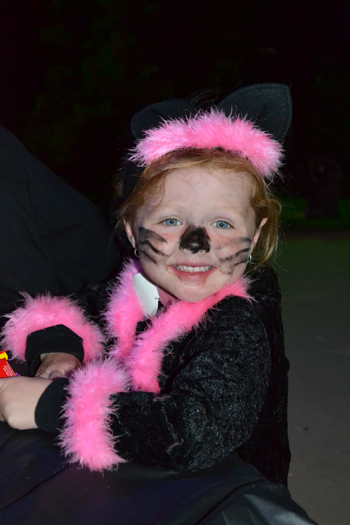
Local youngster enjoying the Orpheum's Trick or Treat event waits for her turn to participate in a hands-on chemistry experiment.
REACT: Reaching and Educating Tomorrow's Chemists Today
October 31, 2013
Dressed in their brand-new Halloween costumes, dozens of pint-sized (and not-so-small) witches, goblins, princesses, and the like made their way to the Trick or Treat event at the Orpheum Children's Museum on Saturday, October 26th. Inside the dimly lit auditorium, they experienced all the expected Halloween ambience: the suspenseful, eerie soundtrack of SPEED looping in the background; a faux graveyard with a giant spider web; the ubiquitous Halloween candy; and something they might not have expected. While participating in hands-on science activities led by Illinois REACT students, they experienced this: learning chemistry can be fun.
REACT (Reaching and Educating America's Chemists of Tomorrow) is a student-run organization which, every semester, gives around 200 chemistry students the opportunity to do just what its name suggests: teach local youngsters about chemistry.
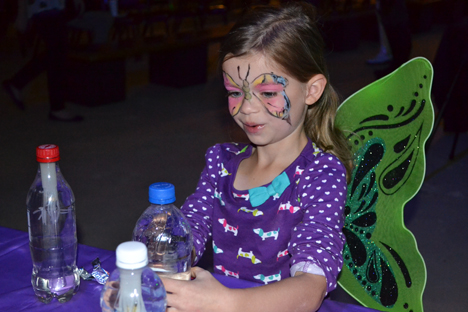
Local youngster in a butterfly costume enjoys making the Cartesian diver go up and down.
During the Halloween-themed Orpheum event, Illinois students were stationed around the room at different experiments. As kids visited their tables, they would give a little spiel about the chemistry involved, then do an interactive activity with them. Of the 20 or so experiments currently in REACT's repertoire, most dealing with common, every-day products available at the grocery store, students did at least a dozen, especially those apropos for a Halloween event. Some were ooey-gooey, such as making slime or dabbling in oobleck, the part-liquid-part-solid stuff made famous by Dr. Seuss. In one experiment, youngsters discovered how different-colored solutions of salt stratify into layers inside a clear straw; in another, they learned about the principle of buoyancy by squeezing a Cartesian diver.
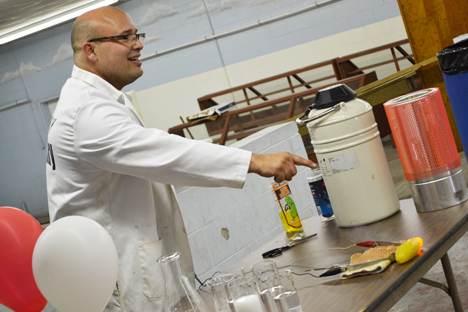
Jesse Miller doing the glowing pickle demo during a chemistry show he did for a boy scout troop in the summer of 2012.
Of the 125 or so outreach events REACT students do throughout the year, many are similar to the Trick or Treat event's smorgasbord-of-different-experiments format; these include family nights at schools, a once-a-semester big event for the Kiwanis girl scout troop, and Chemistry's holiday show. While Jesse Miller, the advisor for REACT and Chemistry's counterpart to Physics' WhysGuy, pulls out all the stops doing showy chemistry magic tricks, replete with liquid oxygen-induced fog and glowing electricity-charged pickles, REACT students offer hands-on activities outside in the hall before and after the show.

A student works on an experiment during a REACT outreach at Barkstall Elementary during spring 2013.
However, while a couple dozen REACT students participated in Saturday's outreach, the organization's bread and butter is teams of three or four doing outreach in the grade 3 classrooms of 45 local schools. Why third grade? Jesse Miller feels it's the optimum grade in their school career to get kids hooked on science, before they get caught up the whirlwind of extra-curricular activities.
Grant Blazina, the 2013 REACT coordinator, explains:
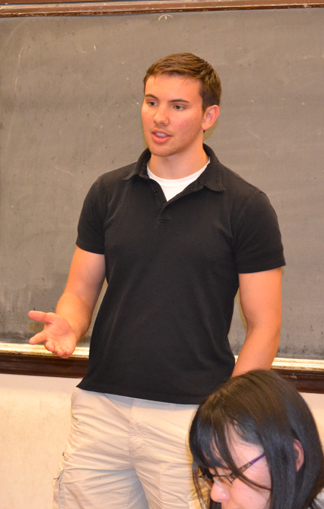
Grant Blazina explains procedures to REACT volunteers during an early fall 2013 training session.
"Jesse likes to say that we do it in 3rd grade because that's the age before sports gets to them. That's the best time to get them interested in science, before something else absorbs all of their time. Before that—like 2nd or 1st grade—they might be too young to follow along and do the experiments. Third grade seems to be a good age to try to get them interested in chemistry and science in general."
Do they expect the kids to learn any chemistry while experiencing their shows? According to Miller, if they do, it would just be icing on the cake: "It's not my goal in this program for 3rd graders to learn anything. If they do—that's great—but it's to make science fun and interesting. Hopefully they learn something. We aren't going in there to be clowns, but we want them to be interested and have fun with it."
Though Miller didn't start REACT, he's been with the program since the beginning. Back around '93 when he was still a student, Steve Zumdahl, then faculty advisor for American Chemical Society (ACS) student affiliates, began the "Kids in Chemistry" program. Around 30 or so ACS affiliates would go into grade schools during Chemistry week in October and do demonstrations for the kids. A student working for the department, Miller prepped the students. Then someone got the idea to do the program as the honors project for students in the James Scholars program. Again, Miller prepped students doing demos, which evolved into doing activities in schools. Then, around 2004, the program, now called REACT, expanded to include all James Scholars in all the general chemistry courses. So overnight, the program exploded, going from 60 to 300 students.

Two youngsters at the Orpheum's Trick or Treat event appreciate the ooey-gooey qualities of oobleck.
However, with so many Illinois students in the program, they had to expand it to include local fourth grades. Also around 2004, Miller started doing demos for the Don Moyer's Boys' and Girls' Club, as well as Trick or Treat for Chemistry at the Orpheum. At its peak, REACT has served about 450 volunteers and James Scholars. Miller has since passed the logistics—buying materials, setting up kits, making lesson plans off to students. For example, in 2013, Grant Blazina handles the administrative end, such as scheduling, while Ben Abejuela, as lab manager for our prep room, has the Herculean task of getting supplies for the experiments as well as overseeing the prep room where the demo kits and materials sent out for kids are put together.
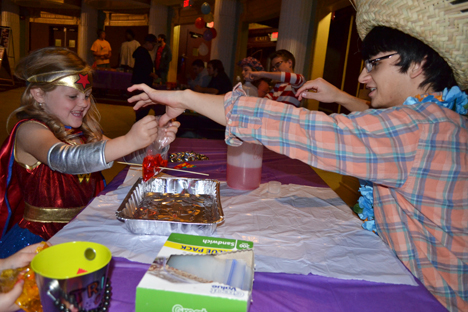
Young Wonder Woman learns about the wonders of chemistry from a REACT student.
So what do Illinois students get out of the program besides providing a venue for James Scholars to complete their honors project?
According to Miller, it gives students a fresh perspective on science. He elaborates by relating an anecdote about doing a demo for some farm kids. After showing them a 10 ml graduated cylinder, he asked, "'Does anybody know what this is?' Remember, these are farm kids, so your paradigm has to shift. So a kid raises his hand and says, 'It's a rain gauge.' And he was absolutely right. In his world, that was a rain gauge."
After a momentary pause, during which Miller processes the kid's answer, then does a slight paradigm shift, he reports that he agreed with the kid. "…You're right!
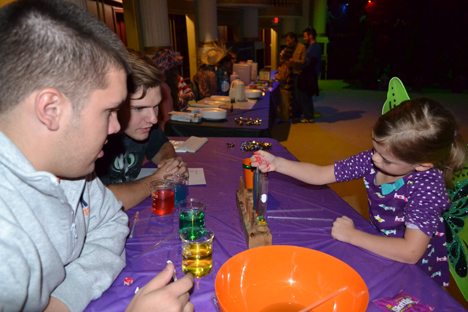
Two REACT students talk a youngster through an experiment involving sodium solutions.
He goes on to describe how looking at science through fresh eyes is beneficial for the REACT students.
"So they get exposed to these things, the things that kids say, and the way they look at science is not the same way that we look at science. I think it's an eye opener for a lot of the students when they're out there working with the kids. Sometimes, they're like, 'Well, I never really thought to look at it the way that kid's looking at it."
What are the benefits for students who are heavily involved. For example, Blazina, Abejuela, and the 15 or so students on the REACT board not only keep the program running, but sometimes even haul students who don't have cars to and from REACT events off campus. What do they get out of it?
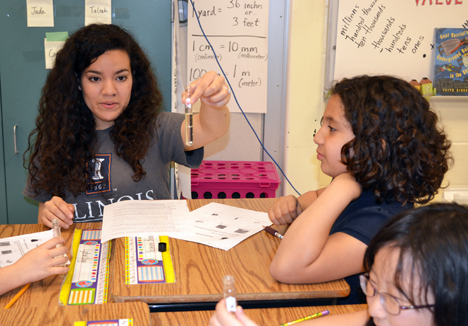
A REACT student discusses the chemistry behind an experiment during outreach at Barkstall Elementary School during spring 2013.
Blazina says he does it to get more people interested in science: "I want to volunteer in the community and give back in some way. I think doing it through a STEM-related field and getting kids interested in chemistry and science is a good way to do it."
And why does Jesse Miller, who's been involved for almost 20 years, do it? "I like doing it," he shares. "I think it's important, and it's worthwhile."
According to Blazina, REACT does chemistry outreach for approximately 2500 elementary age kids annually. Odds are, some of those will surely end up in chemistry. If so, the REACT students can at least gain satisfaction in knowing that they have lived up to their organization's name.
Email REACT
Story and photographs by Elizabeth Innes, Communications Specialist, I-STEM Education Initiative.
More: Chemistry, K-6 Outreach, Orpheum, REACT, 2013
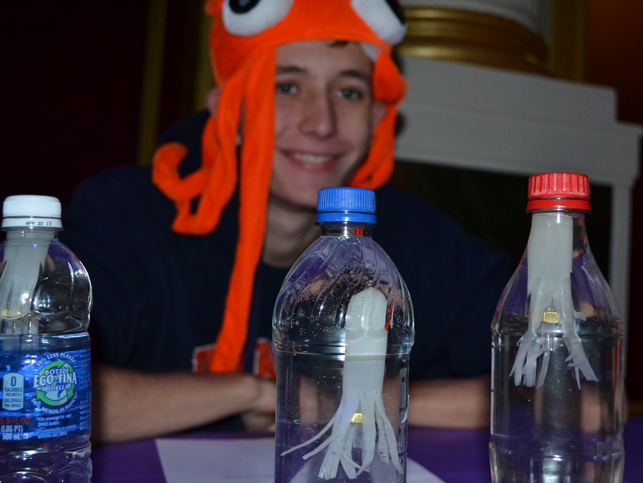
REACT student manning the Cartesian diver station.













.jpg)
















